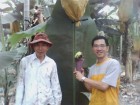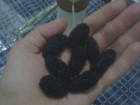A Fruitful Saturday Morning
There is a lot that goes into fruit production in Taiwan and one Saturday this April I was invited to join the banana harvest.

Chen Po Hau’s father is a professional banana farmer. Together they told me a lot about how the fruits come to maturity, starting as a large bud at the top of the plant and ripening to massive clusters, filling out till no “ribs” stand out, then being harvested just before they turn yellow. Each tree bore a single crop after a short eight month season; now it was harvest time.

 To harvest the bananas, his father cut an X in the tough outer “bark” allowing it to bend over. Starting at the end of the cluster he then cut off one bunch at a time. From the smallest bananas at the end, the bananas gradually increased in size as well as number–up to 25 bananas in one bunch.
To harvest the bananas, his father cut an X in the tough outer “bark” allowing it to bend over. Starting at the end of the cluster he then cut off one bunch at a time. From the smallest bananas at the end, the bananas gradually increased in size as well as number–up to 25 bananas in one bunch.



They gave me the chance to try as well. So here in the picture you can see my first bunch coming off the stalk. The stalk was as fibrous as sugarcane and hard to cut at first … but eventually I got the hang of it.


Afterward we visited another garden where lemons, mangos and mulberries were growing. And one more surprise was in store for that morning: there in the undergrowth I was afforded, for the first time, excellent views of the common but hard-to-see Barred Buttonquail.
So as you can see in southern Taiwan weekends as well as weekdays can be tremendously educational, enjoyable and, well, fruitful and productive!
Wow, great post and pictures. What an adventure.
Yum, Yum! David has one question – “why did you pick them green?” My only guess was that they were going to be shipping them far away. Have you ever eaten any bananas that turned yellow on the “tree”?
I really enjoyed that post Donald!
I did know that bananas were an herbaceous plant and not a tree, but I didn’t know they “cut them over” to pick the fruit; do they have to plant new trees every year – or tie them back up?
I think bananas will burst their skins if left to ripen on the tree, but can still be picked later if they will not be shipped far. I’ve been told by several people with firsthand knowledge that there is NO comparison between locally grown bananas and those shipped to distant places like the U.S. Maybe I’ll get to try “real” ones some day.
Yes they do have to be replanted but young plants will naturally sprout up around the base of the older tree which makes it easy to keep the cycle going. Usually they put the new trees in place before the older ones die and Po Hao said yesterday that they spent last Saturday planting 800!
Today I asked him if you could wait for the bananas to ripen on the tree. He said that you could, particularly from home, but the bananas at the top would ripen first, which means there is never a time that you could just cut down the whole cluster yellow: you would have to harvest them a little at a time. They always harvest them green if they are to sell–near or far. Instead of judging by color, you can tell the bananas are ready for harvest when they are round and filled out–without the ribs in the peel standing out very much. So, now you know how to tell a good banana and, no, I haven’t had the privilege of eating any tree-ripened fruit yet but maybe it wouldn’t make that much difference here!
Chen Po Hau’s father looks like a person who enjoys what he does. That was a great experience. The pictures were very instructional.
Hi!I am Daniel.(In NAN JUNG English Village)
Donald,I didn’t recive the e-mail (Chen Po Hau’s teacher picture).